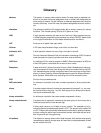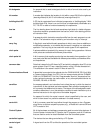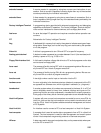
Glossary
541
counter A dedicated group of digits or words in memory used to count the number of
times a specific process has occurred, or a location in memory accessed
through a TC bit and used to count the number of times the status of a bit or an
execution condition has changed from OFF to ON.
CPU An acronym for central processing unit. In a PC System, the CPU executes the
program, processes I/O signals, communicates with external devices, etc.
CPU Backplane A Backplane which is used to create a CPU Rack.
CPU Rack Part of a building-block PC, the CPU Rack contains the CPU Unit, a power sup-
ply, and other Units. With most PCs, the CPU Rack is the only Rack that provides
linkable slots.
CTS An acronym for clear-to-send, a signal used in communications between elec-
tronic devices to indicate that the receiver is ready to accept incoming data.
cycle The process used to execute a ladder-diagram program. The program is ex-
amined sequentially from start to finish and each instruction is executed in turn
based on execution conditions.
cycle time The time required for a single cycle of the ladder-diagram program.
data area An area in the PC’s memory that is designed to hold a specific type of data, e.g.,
the LR area is designed to hold common data in a PC Link System. Memory
areas that hold programs are not considered data areas.
data area boundary The highest address available within a data area. When designating an operand
that requires multiple words, it is necessary to ensure that the highest address in
the data area is not exceeded.
data sharing An aspect of PC Link Systems and of Data Links in Net Link Systems in which
common data areas or common data words are created between two or more
PCs.
debug A process by which a draft program is corrected until it operates as intended.
Debugging includes both the removal of syntax errors, as well as the fine-tuning
of timing and coordination of control operations.
decimal A number system where all numbers are expressed to the base 10. In a PC all
data is ultimately stored in binary form, four binary bits are often used to repre-
sent one decimal digit, via a system called binary-coded decimal.
decrement Decreasing a numeric value.
default A value automatically set by the PC when the user omits to set a specific value.
Many devices will assume such default conditions upon the application of power.
definer A number used as an operand for an instruction but that serves to define the
instruction itself, rather that the data on which the instruction is to operate. Defin-
ers include jump numbers, subroutine numbers, etc.
delay In tracing, a value that specifies where tracing is to begin in relationship to the
trigger. A delay can be either positive or negative, i.e., can designate an offset on
either side of the trigger.
destination The location where an instruction is to place the data on which it is operating, as
opposed to the location from which data is taken for use in the instruction. The
location from which data is taken is called the source.


















